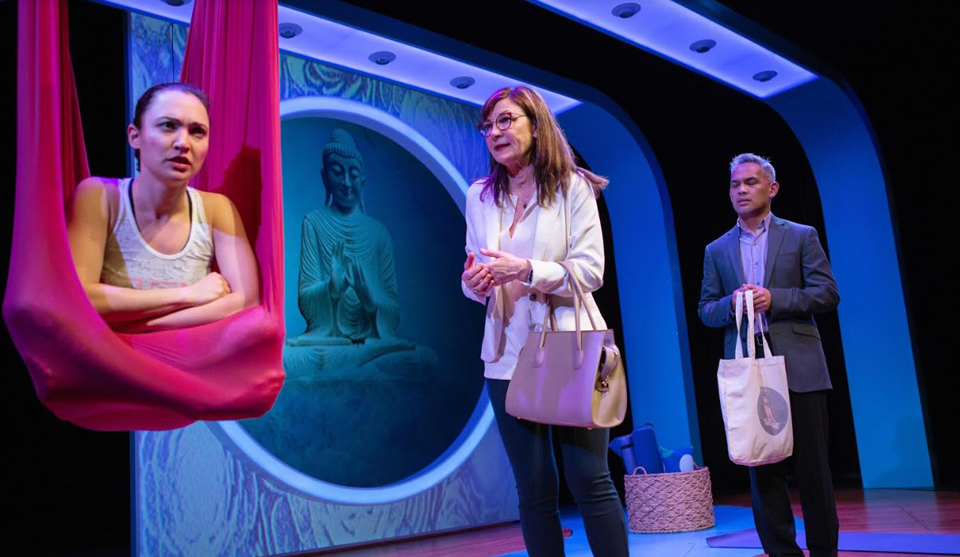
LAGUNA BEACH, Calif.—Calcutta-born playwright Dipika Guha’s comedy Yoga Play is the latest installment in the tradition of works about and interactions between “mystical” Easterners encountering Westerners living in the material world who seek enlightenment. As Yoga Play drolly dramatizes, sometimes those partaking of this spiritual quest in our corporeal realm get their wires crossed. The search for inner illumination can be monetized in a society dominated not by piety but by materialism, turning serenity into obscenity and putting the nasty into “Namaste.”
In Guha’s two-actor, Jojomon is a multi-national corporation manufacturing garb used by practitioners that are rocked by a scandalous revelation. To counter what could be a monsoon of bad PR, Jojomon executive Joan (Susi Damilano, an Off-Broadway award-winning actress from San Francisco, where Yoga Play had premiered), a beleaguered woman competing in the male-dominated corporate world, decides to take desperate measures to save the image-conscious company’s reputation (and stock prices).
Jojomon imports an Indian guru from the Himalayas to its SoCal HQ, but the arrival of this purported holy man is a holy mackerel moment. Instead of rescuing Jojomon from its embarrassing brouhaha, when Guruji (Joe Estlack, who also cleverly plays a head of the corporation) is unveiled, so to speak, it could result in an even bigger contretemps. Let’s just say it’s a case of “East meets West meets pest.”
Thus ends the mildly amusing first act with this big surprise for the Jojomon execs, Joan, Fred (Philippines-born Ryan Morales as a character purported to be of Chinese ancestry) and Raj (Bobak Bakhtiari), a thoroughly Americanized son of Indian immigrants.
The second act opens with the same double take and is brisker and funnier than Act I, which basically serves to setup Act II, and does pay off. Mistaken identity, a theatrical mainstay stretching back past Shakespeare all the way to the Greeks, ensues, with dramatis personae swapping personas. And as in real life (such as the Beatles’ song “Sexy Sadie” allegedly alludes to) there’s some hanky-panky between the holier than thou Guruji and Romola (Ayelet Firstenberg, who like others in the cast has a double role), a yoga instructor at a posh SoCal studio searching for her own form of inner fulfillment.
Guha’s funny take on cosmic consciousness brushes on some serious issues now in the news, such as what Yoga Play calls “brownface” and “bronzeface,” the equivalent of the blackface used by white performers in minstrel shows, stereotypical movies, etc., to make themselves appear as if they are of (dubious) African descent. The subject of cultural misappropriation and ethnic authenticity and identity permeates this satire, which Guha relishes poking fun at.
Yoga Play is playful in its form, as well as its content. As the actors perform offstage against a green screen they are sometimes projected onstage on a screen, a fairly innovative technique I’ve only seen a few times before in a theater. (Kudos to sound and projection designer Teddy Hulsker.) The playbill is likewise playful as its credits are designed, shall we generously say, to throw audiences off the scent. (Our unenlightened head case of state might call this an example of “fake news!”)
Some prominent examples of this East-meets-West trend include the supposed Indian holy man J. Krishnamurti, who was discovered in India around 1909 by wealthy Theosophist Annie Besant, co-founder of the Ojai Foundation. She proclaimed him to be a sort of messiah, but by 1929 he renounced Besant’s Order of the Star in the East religious group. Nonetheless, Krishnamurti continued on the path to enlightenment as a spiritual teacher, believing each person must be his own guru. The Krishnamurti Library and Study Center still exists in Ojai where, incidentally, Frank Capra shot the mountains that double for Shangri-La’s Himalayas in his 1937 movie Lost Horizon, based on James Hilton’s novel.
Somerset Maugham’s 1944 The Razor’s Edge is another novel that deals with this theme and was also adapted for the screen, in 1946 and 1984 movies starring Tyrone Power and Bill Murray. Other films along these lines include the comedies 1969’s The Guru starring Michael York, directed by James Ivory and co-written by him with Ruth Prawer Jhabvala; 2002’s The Guru, a sex comedy starring Marisa Tomei and Heather Graham; 2008’s The Love Guru starring Mike Myers, Jessica Alba, Kanye West and Deepak Chopra (as himself). In real life, the Beatles’ 1968 trip to Transcendental Meditation maestro Maharishi Mahesh Yogi’s ashram in Rishikesh, India, is probably the most famous real-life example of this trend, along with George Harrison’s ongoing adherence to a form of Hinduism.
I enjoyed seeing costume designer Rachael Heiman’s duds, in particular, the yoga toga. Guha’s ha-ha comedy, directed by Bill English, is the latest in a long line of East meets West meets jest works and real-life encounters between Caucasians and would-be high lamas, who often turn out to be just Dharma bums.
Yoga Play plays through Oct. 13 on Weds. through Sat. at 7:30 p.m, also 2:00 p.m. on Sat., Sun. at 1:00 and 5:30 p.m., and on Thurs., Oct. 10 at 2:00 p.m., at the Laguna Playhouse, 606 Laguna Canyon Rd., Laguna Beach 92651. For more info, call (949) 497-2787 or go to www.LagunaPlayhouse.com.










